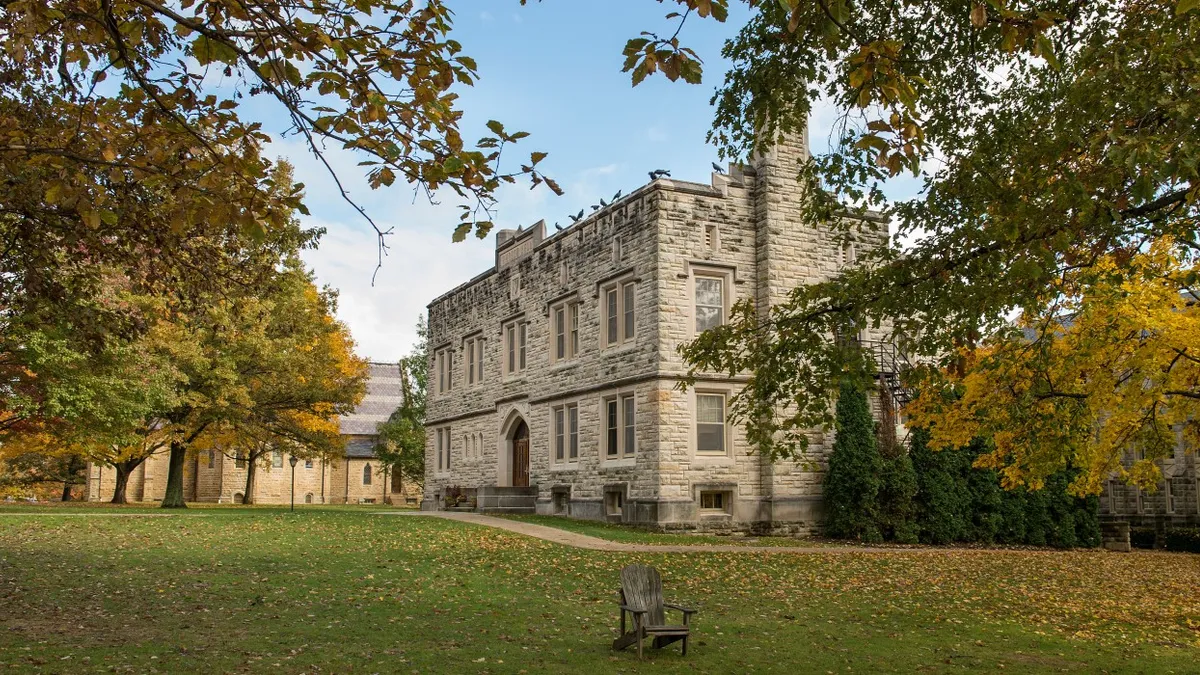Dive Brief:
- Kenyon College, a small liberal arts institution in Ohio, has revised its guidelines for tenure and promotion to include recognition of faculty members' diversity and inclusion efforts. The change is the first revision to the guidelines in nearly two decades and goes into effect July 1.
- The revised guidelines now include criteria to measure a faculty members' "promotion of an inclusive classroom environment that values diversity" and their contributions to programs that "strengthen inclusivity, diversity or access to liberal education."
- The changes, which faculty members voted in favor of in September, are the culmination of a yearlong effort. "The faculty, and the College, wanted to make changes that would better reflect the efforts that Kenyon faculty have long put forth in their teaching and advising, and that would also better encourage and recognize faculty involvement in inclusion efforts," Kenyon spokeswoman Mary Keister wrote in an email to Education Dive.
Dive Insight:
Baking diversity and inclusion efforts into Kenyon's hiring and tenure guidelines highlights its importance at a time when many minority faculty members have voiced that they are overburdened with such work, which can often go unacknowledged and hinder their career advancement.
At the same time, diversity courses — which tend to be disproportionately taught by women and members of underrepresented groups — take a higher emotional toll on faculty members than others classes do. That's because sensitive topics discussed in such courses often prompt students to share their personal struggles or talk out an issue with professors outside of class, The Chronicle of Higher Education reported, citing a recent paper on the subject.
"Students who come into my office crying, they're not crying about their papers, or their grades," one professor said in the paper. "They're coming in talking about microaggressions, about things that happen on campus, things people are saying to them."
Kenyon isn't the only college taking steps to recognize and reward this type of work. Last year, the University of California, Los Angeles announced it would require faculty applicants to provide a statement about their past and planned contributions to equity, diversity and inclusion.
That decision was met with immediate blowback from some corners of the higher education community. The former dean of Harvard University's medical school tweeted that the requirement and others like it are an "affront to academic freedom," while others have suggested that a focus on such work would detract from scientific and academic discovery.
Yet recognizing this type of "invisible labor" could be one way to increase diversity among faculty, especially as the gap between the share of black and Hispanic students and faculty members continues to widen.
California Lutheran University saw some success in bridging that divide when the college set out to tackle its own problem: a 50% nonwhite student population taught by a predominantly white (82%) faculty.
After spending $100,000 on advice from outside advisers, the university overhauled its recruitment process for faculty positions, The Chronicle reported. Its job ads now promote that it is a Hispanic-serving institution and has a preference for professors who can serve as mentors for minority students. Following the change, the university hired 11 new faculty members and one dean during the 2016-17 academic year, two-thirds of whom were people of color.
Race is only one piece of the puzzle. Hiring faculty with a diversity of age, sexual orientation, religion, nationality and socioeconomic backgrounds helps colleges better respond to challenges that require multiple perspectives, according to a report by the Council of Colleges of Arts and Sciences.
"[T]his problem can be solved," wrote Estela Mara Bensimon, a professor at the University of Southern California who led the team that overhauled Cal Lutheran's hiring, in an op-ed for Inside Higher Ed. "Indeed, if we're to reach our goals for postsecondary attainment, it must be."











